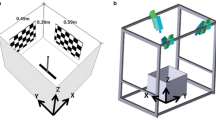Abstract
The ability of the localizing system of the dolphin Tursiops truncatus to discriminate the dynamic characteristics of an object being located (a radially moving target) was studied. Measurements were made of the thresholds of the animals’ sensitivity to the target speed (2.6 cm/sec) and acceleration (0.6 cm/sec2). For location of a target moving at constant speed, dolphins were found to use probe signals consisting of two impulses, while accelerating targets were located using probe signals consisting of three impulses. These characteristics were used to propose new and highly effective technical methods for hydrolocation and radiolocation.
Similar content being viewed by others
References
É. Sh. Airapetyants and A. I. Konstantinov, Echo Location in Nature [in Russian], Nauka, Leningrad (1974).
V. M. Ginzburg, Real-Time Image Formation and Processing. A Rapid Scanning Method [in Russian], Radio i Svyaz’, Moscow (1986), p. 34.
D. U. Griffiths, “A theory of sonar systems applied to biological organisms,” in: Cybernetic Questions in Bionics [in Russian], Moscow, Vol. 1, pp. 321–337 (1971).
D. R. Griffin, Echo in the Lives of Humans and Animals [in Russian], Fiz-Mat. Literat., Moscow (1961).
N. A. Dubrovskii, Echo Location in Dolphins [in Russian], Central Science Research Institute Rumb, Moscow (1976).
A. P. Evtyukhov, A. E. Kolesnikov, and E. A. Korepin, Handbook of Hydroacoustics [in Russian], Sudostroenie, Leningrad (1988), Second edition, p. 16.
Yu. G. Zhukovskii, K. A. Zaitseva, A. I. Krivchenko, and V. I. Korolev, Russian Federation Patent No. 2171999, August 10, 2001, “A method for identifying the movement parameters of a location object and an apparatus for this purpose,” MKI-7 G 01 S 1/14.
Yu. G. Zhukovskii, Russian Federation Patent No. 2163723, February 27, 2001, “A method for identifying the movement parameters of a location object,” MKI-7 G 01 S 1/14.
K. A. Zaitseva and V. I. Korolev, “The resolving ability of the bottlenose dolphin location system for discriminating the speed of a moving target,” Sensor. Sistemy, 8, No. 2, 25–33 (1994).
K. A. Zaitseva and V. I. Korolev, “Studies of the ability of the sonar of the bottlenose dolphin to determine the acceleration of a moving target,” Sensor. Sistemy, 10, No. 31, 56–63 (1996).
K. A. Zaitseva and V. I. Korolev, “The mechanism by which the sonar of the dolphin Tursiops truncatus measures the speed and accelerator of a moving hydrolocation target,” Zh. Évolyuts. Biokhim. Fiziol., 36, No. 2, 136–140 (2000).
A. I. Konstantinov, A. K. Makarov, B. V. Sokolov, and E. É. Lipmanova, The Doppler Echo Location Systems of Animals. Questions in Neurophysiology. The Nervous System [in Russian], Leningrad State University, Leningrad, No. 20, pp. 46–58 (1978).
É. A. Levin, V. A. Protasov, and V. A. Saprykin, “The resolving ability of the auditory analyzer of dolphins on measuring the speed of a moving sound source,” in: Marine Mammals [in Russian], Nauka, Moscow (1978).
A. K. Makarov and B. V. Sokolov, Compensation of Doppler Shifts in the Echo Location Systems of Animals. Sound Communication, Echo Location, and Hearing [in Russian], Leningrad State University, Leningrad (1980), pp. 65–72.
M. N. Sukhoruchenko, “Frequency discrimination in dolphins,” Fiziol. Zh. SSSR, 9, No. 8, 1205–1210 (1973).
Ya. D. Shirman (ed.), Theoretical Bases of Radio Location [in Russian], Sovetskoe Radio, Moscow (1970).
D. A. Cahlander, “Echolocation with wideband waveforms but sonar signals,” Techn. Rep. Lincoln. Lab. MIT, 271, 544–546 (1964).
R. Hikling, “Analysis of echoes from a solid elastic sphere in water,” J. Acoust. Soc. Amer., 34, No. 10, 1582–1591 (1962).
T. C. Poulter, “The use of active sonar by the California sea lion,” J. Audit. Res., 6, 165–173 (1966).
Author information
Authors and Affiliations
Additional information
__________
Translated from Rossiiskii Fiziologicheskii Zhurnal imeni I. M. Sechenova, Vol. 91, No. 8, pp. 872–884, August, 2005.
Rights and permissions
About this article
Cite this article
Zhukovskii, Y.G., Zaitseva, K.A., Krivchenko, A.I. et al. Mechanisms by which dolphins identify target movement characteristics and their technical use in hydrolocation and radiolocation. Neurosci Behav Physiol 36, 801–809 (2006). https://doi.org/10.1007/s11055-006-0090-0
Received:
Revised:
Issue Date:
DOI: https://doi.org/10.1007/s11055-006-0090-0




